We Believe!
For more than 150 years, OWU alumni have helped Cleveland rock as a leader in industry, commerce, the arts, sports, and civic engagement. That tradition continues today with new generations of Bishop alumni who call “Believeland” home.
Don’t call it a comeback. If you’re from Cleveland, you get it. The appeal, the pride and the potential. It may not be the biggest city in the country, but Cleveland has always been small and mighty. Over the last decade, there’s been a focus on revitalizing Cleveland’s downtown and neighborhoods, attracting new residents, and making it a destination.
Nestled along Lake Erie, Clevelanders embrace the city’s Midwestern roots by working hard, being friendly, and taking care of each other. That Rust Belt mentality has inspired change and innovation.
With popular spots like the Rock & Roll Hall of Fame, the West Side Market, and the Cleveland Museum of Art, Cleveland has become an unexpected stop for tourists as well as an affordable option for those looking to settle down and raise a family.
Ohio Wesleyan alumni have a long history of traveling north to build a career in Cleveland and to help build Cleveland into an economic and industrial powerhouse and a center for the arts in the Midwest.
Mary Bigelow (Janes) Ingham, a Professor of French and Belles-Lettres in the 1860s at Ohio Wesleyan College for Women and honorary degree recipient in 1869, was one of the great social activists of 19th-century Ohio. After a teaching career, she co-inaugurated the Women’s Foreign Missionary Society in Cleveland; was a charter member of the Cleveland Woman’s Press Club; cofounded the Cleveland School of Art (now the Cleveland Institute of Art); and authored the book Notable Cleveland Women as well as a history of the Methodist Episcopal Churches of Cleveland.
Myron Herrick studied at OWU in the early 1870s, moved to Cleveland working in law and finance, served on Cleveland City Council, was president of a bank, and helped found the National Carbon Company, a predecessor of Union Carbide and Eveready. He later served as Ohio governor and U.S. ambassador to France.
James Nance, Class of 1923, was chief executive of the Central National Bank of Cleveland, the first chairman of the board of trustees of Cleveland State University, and a trustee for University Hospitals of Cleveland.
Entrepreneurs and business and finance leaders like Evan Corns ’59, cofounder of America’s Body Co.; Carol Latham ’61, founder of Thermagon, Inc.; Curt Moll ’61, former chair and CEO of MTD Products; and Bob Gillespie ’66, former president and CEO of Society National Bank and KeyCorp, created jobs and economic growth.
Former Rolling Stone magazine editor Jim Henke ’76 became the curator for the Rock & Roll Hall of Fame. And even in fictional Cleveland (Make-Believeland?) Wendie Malick ’72 created Cleveland’s “Queen of Daytime” Victoria Chase for the Emmy-winning sitcom Hot in Cleveland.
Today, new generations of OWU alumni are rocking Cleveland.
For many, the possibility of making a difference in Cleveland was one of the reasons they returned to their hometown. The connections you can make and the ability to be involved in shaping the city are appealing.
“When I think about my network here in Cleveland and how I can get involved, be impactful, and make a difference, there’s no question that the construct of Cleveland allows for that,” says Julie Tutkovics ’92. “It’s a small town inside of a big town.”
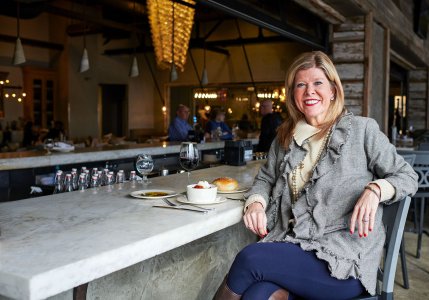
Originally, Tutkovics wanted to pursue a career in the investment side of banking. But an opportunity steered her toward communications, which led to positions with FirstMerit, New York Community Bancorp Inc., Citizens Financial Group, Fidelity Investments, and KeyCorp. She is now the executive vice president and chief marketing and communications officer for Huntington Bank. “I’m somewhat unique in the fact that I have continued to work for very large companies, some of which are headquartered in Cleveland,” says Tutkovics. “But I’ve always had such a strong desire to live in Cleveland and I’ve been able to make that work.”
Tutkovics spent some time living in Boston but knew she wanted to return to Cleveland to pursue her career in marketing for financial institutions and to find ways to contribute philanthropically. “I grew up in a family that was incredibly involved in Cleveland,” she says.
Her mother was president of the Junior League, and the desire to give back was instilled in her from an early age. “I always felt like there was tremendous opportunity here,” she says.
Today Tutkovics, the executive vice president and chief marketing and communications officer for Huntington Bank, sits on the board of nonprofits such as Destination Cleveland and Footpath Foundation. “The opportunity to come back to Cleveland and then be able to give back was always something that I wanted for my own life,” she says.
Finding that sense of purpose was important to Stacey McKinley ’82. She’s had an impressive career, first working in broadcast journalism, including a stint as cohost of “Good Morning, Kentucky” in Lexington. She then came back to Cleveland to attend law school at Cleveland-Marshall College of Law, where she now serves as an adjunct professor.
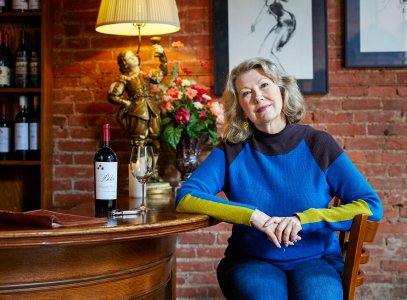
Before pivoting to a career in philanthropy, McKinley worked at three Cleveland law firms—Jones Day, Kahn Kleinman and Ulmer & Berne—where her legal practice focused on finance, real estate, business, and nonprofit law. She uses that experience as an adjunct professor at Cleveland-Marshall College of Law, where she teaches nonprofit corporations. Now as the director of gift planning at the Cleveland Clinic’s Philanthropy Institute, she works with Cleveland Clinic donors. “I get to meet people at their best,” says McKinley. “They want to give for a variety of reasons and they have fascinating stories.”
“Cleveland was always home,” she says. “You’ll always find opportunity here.”
After years of working for local law firms, McKinley made the jump to a career in development and fundraising, working for Cleveland State University and now at the Cleveland Clinic as director of gift planning at its Philanthropy Institute.
“I’m very grateful that I happened to come into a career that allows me to use my legal background with philanthropy,” she says.
With the Cleveland Clinic’s recent centennial campaign, the Philanthropy Institute helped raise more than $2 billion in donations. Those funds have helped in a multitude of ways, from advancing the study of a breast cancer vaccine to providing free eye exams and eyeglasses to children in underserved communities.
“Cleveland is a great place when it comes to philanthropy,” she says. “There are so many ways to get involved.”
That sense of kindness can be traced back to the start of the Cleveland Foundation, the world’s first community foundation, in 1914. For the past decade, Kaye Ridolfi ’83 served as its senior vice president of advancement and saw firsthand how gifts small and large can make an impact in the community.
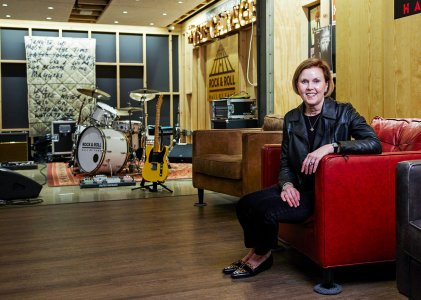
In March, Ridolfi was named vice president of development at the Rock & Roll Hall of Fame, after more than a decade in a similar role with the Cleveland Foundation. She also has worked in development with another great Cleveland organization, Case Western Reserve University, as well as Ohio Wesleyan. “I know that the work I do is helping to make some part of the world a better place,” she says. “People in Cleveland are very generous.”
People in Cleveland are very generous.
For example, the organizational funds launched by the Cleveland Foundation support Northeast Ohio nonprofits such as Ideastream Public Media and the Near West Theatre with their missions but also help them invest equitably.
“We really focused on making Cleveland a better place by helping people to be thoughtful about what they want to do with their money,” she says.
Originally from central Ohio, Ridolfi says she was thrilled to join the Rock & Roll Hall of Fame in March as vice president of development. “Their incredible exhibits, educational programs, and events have enriched the lives of all in our region and around the world. This is an exciting time in the museum’s development to ensure the continuity of the institution for generations.”
“I know that the work I do is helping to make some part of the world a better place,” she says. “People in Cleveland are very generous.”
For Hasani Wheat ’09, who grew up in Cleveland’s Harvard-Lee neighborhood, participating in community service is what drives him. Wheat has volunteered at the Greater Cleveland Food Bank and trash cleanups along Edgewater Beach. He also serves as the president of the Kiwanis Club of Cleveland.
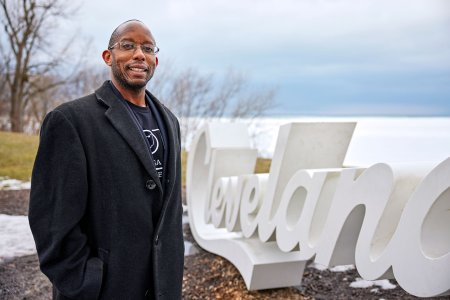
As the program coordinator for the registration department at the Cuyahoga County Board of Elections, Wheat helps the registration management team plan and execute petition verification and provisional processing and conduct periodic inventory inspections to prepare for elections. Active in serving his community, his favorite service projects include cleaning up trash at Edgewater Beach and volunteering at the Greater Cleveland Food Bank. “Community service is important because you never know when someone is going to be in need,” he says.
You can actually be part of a neighborhood and feel like you have some type of say.
“It was a no-brainer to come back to Cleveland,” he says. “Coming back and being able to see how things were changing and actually being a part of that change made it really easy for me to be like, well, I want to just stay in Cleveland.”
In his role as program coordinator for the registration department at the Cuyahoga County Board of Elections, he’s had an opportunity to learn about Cleveland’s neighborhoods and all they have to offer—from walkable communities, family-owned businesses, and engaged residents.
“It’s one of those things where you don’t have to live in a cocoon anymore,” he says. “You can actually be part of a neighborhood and feel like you have some type of say.”
Building a sense of community and addressing the health and economic inequities that exist in the city is why Cleveland native Shelli Reeves ’16 founded Reframe History, an organization dedicated to keeping stories alive through archiving the past, recording the present, and advocating for the future.

Reeves is dedicated to breaking down barriers and building community. As the founder and CEO of Reframe History, an organization dedicated to keeping stories alive through archiving the past, recording the present and advocating for the future, Reeves is an influential Black voice in Cleveland. “I’m telling the stories of African American people who are living in Cleveland right now,” she says. “The way that I can interact with community on so many different levels brings me so much joy.”
“Cleveland is extremely significant in African American history because of the Great Migration and how many people moved from down South up to Cleveland because of the industry that we had here,” she says.
The ability to create a business and get advice from others is something that Reeves appreciates about Cleveland, where she’s also worked at the Cleveland Museum of Art and Ideastream Public Media.
“In Cleveland, there are a lot more people trying to innovate, which is exciting,” she says. “I still think that we have a long way to go. But I have been able to find other people who are creating tech startups and other people who are engaging in trying to start businesses that are really going to push the envelope of what it means to have a business.”
In the past decade, small businesses of all kinds have seen an influx of support from Clevelanders. Makers markets, pop-up shops, and social media have helped mom-and-pop businesses, artisans, and chefs flourish.
Having a network of creatives is one of the reasons that experimental painter Madelaine Mavec ’14 returned to Cleveland to start Mavec Collections, a gallery that features her fine art designs on paper, fabric, and leather.
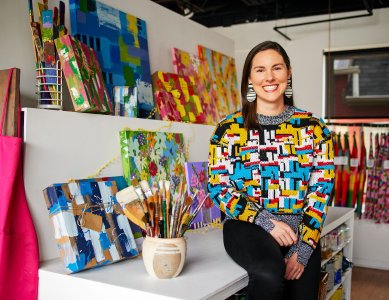
As an experimental painter, Northeast Ohio native Mavec makes use of bright colors and various applications of paint. She opened Mavec Collections in downtown Chagrin Falls to showcase her fine art designs on paper, fabric, and leather. Her pieces can be seen around Cleveland in places such as Sherwin-Williams, University Hospitals, the Cleveland Foundation, the Cleveland Clinic, and Laurel School. “My work is a way for me to bring joy to other people,” she says.
“There are a lot of creatives in Cleveland,” she says. “That’s what’s exciting about being here—Cleveland really is a cultural place. It allows for that type of creative energy to exist here.”
Another important aspect to what Mavec does is support other local businesses with her work. For example, she uses paint from Sherwin-Williams and works with a local printer for her paper products and promotional materials.
“Building those relationships and supporting those individuals in their businesses will only benefit Cleveland in general,” she says. “I try to be really conscious of that.”
Those connections have helped foster an atmosphere where people want to not only work in Cleveland but also stay and build a future. Downtown Cleveland has seen an influx of new residents as well as a slew of new residential construction projects.
“There’s been just an exciting new wave of energy in Cleveland,” she says.
Michael Kubinski ’02, founder of CLE Clothing Co., can attest to the positive vibes. What started as a T-shirt company in a basement has expanded to four retail locations and now includes a variety of Cleveland-inspired apparel and accessories.
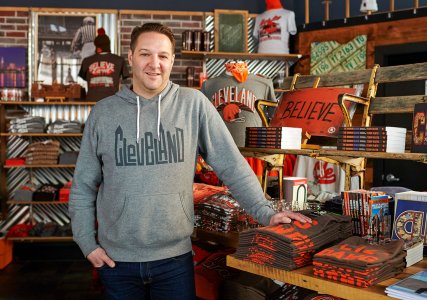
Kubinski was working as a junior graphic designer for a consumer goods company when he started screen-printing T-shirts with a friend as a “creative outlet.” They eventually focused on making T-shirts that celebrated Cleveland pride. In 2008, he founded CLE Clothing Co. with items that show love for all things Cleveland—think the West Side Market, polka, Progressive Field, and Lake Erie. Today, Kubinski oversees four retail locations and an online store with around 30 employees. “It’s not just a job, it’s a family for us,” he says. “My wife and I, we literally are a mom-and-pop shop.”
The people here just really love the city, love the hard work ethic and Cleveland’s underdog mentality.
“We created something where people can show and wear their pride,” he says. “The people here just really love the city, love the hard work ethic and Cleveland’s underdog mentality.”
When he opened CLE Clothing Co.’s flagship store on East Fourth Street in downtown Cleveland back in 2012, Kubinski could already see the beginnings of the city’s revival.
“We saw this great resurgence of Cleveland pride and it just continued,” he says. “Now we’re just seeing more apartments and more people living downtown compared to what it was 10 years ago. We can see the city changing right before our eyes.”
Part of the city’s success comes from leading organizations in town working together for a common goal. Marty McGann ’02 knows this firsthand from the variety of projects he’s worked on as the executive vice president of advocacy and strategy at the Greater Cleveland Partnership, the largest metropolitan chamber of commerce in the United States.
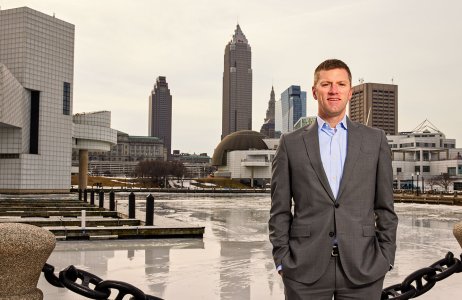
McGann is working towards a better Cleveland as the executive vice president of advocacy and strategy at the Greater Cleveland Partnership, the largest metropolitan chamber of commerce in the United States. McGann is responsible for the execution of GCP’s three-year strategic plan with a focus on worker mobility, innovation, and tax/ competitiveness. “I’ve had the good fortune of getting to work on really exciting projects for our community,” he says.
We’re part of a big collaboration with a lot of stakeholders.
“There’s nothing that GCP does alone,” he says. “We’re part of a big collaboration with a lot of stakeholders. We get to help advance really important issues in Cleveland.”
One of those issues centers around reliable and affordable access to broadband internet for all Cleveland residents. Cleveland is currently the most disconnected large city in the nation. And McGann hopes to change that.
“You can’t grow and expand and develop as a community if a third of your population has no reasonably affordable access to internet,” he says. “We’ve been lobbying the federal, state, and local governments to work with us on solutions to expand internet affordability in our community.”
Other projects that McGann has worked on include the Cleveland Plan, the Cleveland Metropolitan School District’s transformation plan, as well as the extension of Cuyahoga County’s sin tax, which helps maintain and improve Cleveland’s professional sports facilities.
And Cleveland sports is always a hot topic among its residents. That enthusiasm has led the city to host major sports events such as the 2019 MLB All-Star Game, 2021 NFL Draft, and the 2022 NBA All-Star Weekend.
“We are the smallest city in America that has three major sports teams,” says Bob DiBiasio ’77, the senior vice president of public affairs for the Cleveland Guardians. “With all those events we attracted to the city, Cleveland has put itself on the map in a really extraordinary way.”
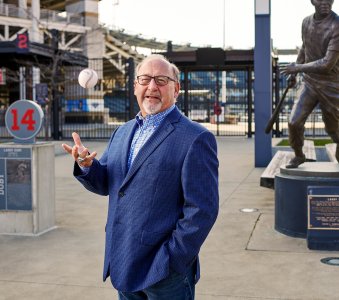
DiBiasio loves baseball. The Northeast Ohio native has worked for Major League Baseball for 44 seasons: 43 with the Cleveland Guardians and one with the Atlanta Braves in 1987. He says from an early age he wanted to work for his hometown team. “The Guardians are a rallying point for our community, where people can gather and have fun,” he says. “We take that responsibility very seriously.”
DiBiasio lives and breathes sports. In addition to working for MLB teams for an impressive 44 seasons, he’s also the president of the Greater Cleveland Sports Hall of Fame. He knows how much teams like the Guardians, Browns, and Cavaliers mean to the city.
“We believe that not only do we provide terrific entertainment and service to others, but there’s a communal spirit that we are a part of,” he says.
That shared attitude goes beyond just winning games. As a testament to Cleveland’s philanthropic roots, many top organizations in town focus on giving back to Cleveland. And for the Cleveland Guardians, charity plays a vital role.
“We are very involved in a number of youth-oriented activities and programs that address the needs of the underserved in our community,” says DiBiasio, who is also president of the Cleveland Guardians Charities. “Folks focused on helping and serving others—that’s part of the DNA of Cleveland, which I think makes us incredibly strong community.”
By Kim Schneider ’01, manager of communications at Cleveland Clinic and the former editor of Cleveland Magazine.
This is the second in a series of articles on OWU’s favorite cities. You can read about Washington, D.C., alumni in the Winter 2020 issue. Please let us know why your city should be the next one we feature in OWU Magazine.
